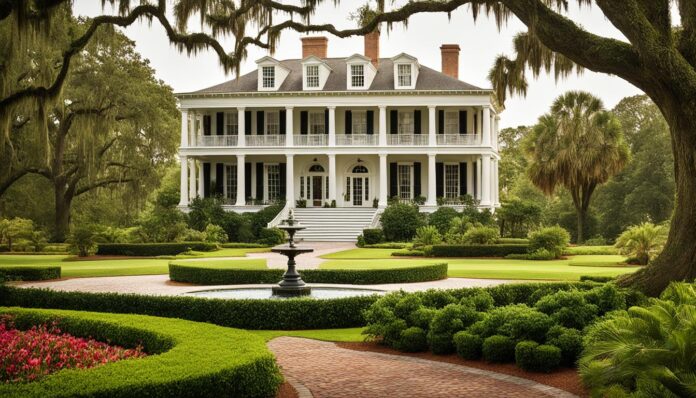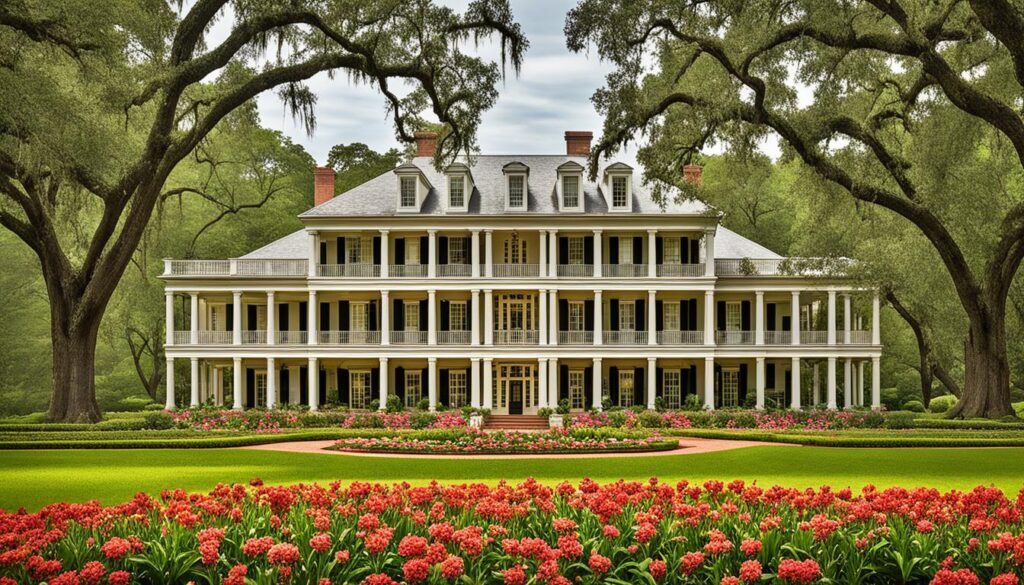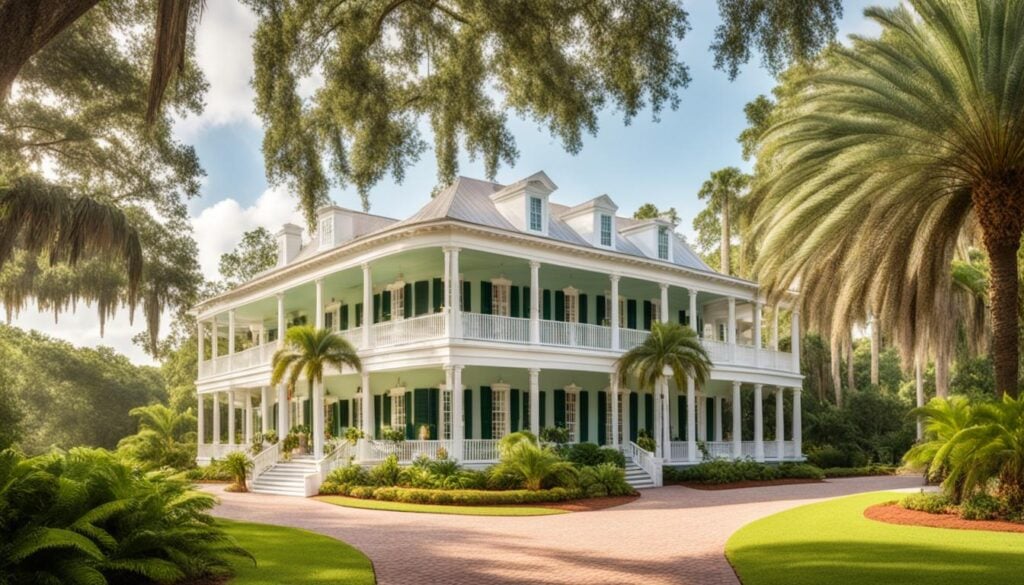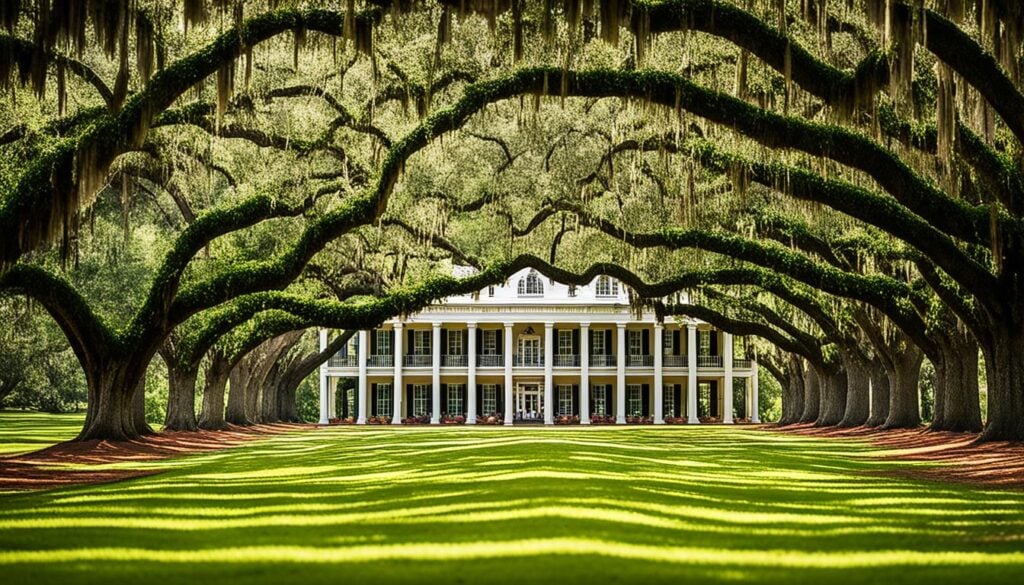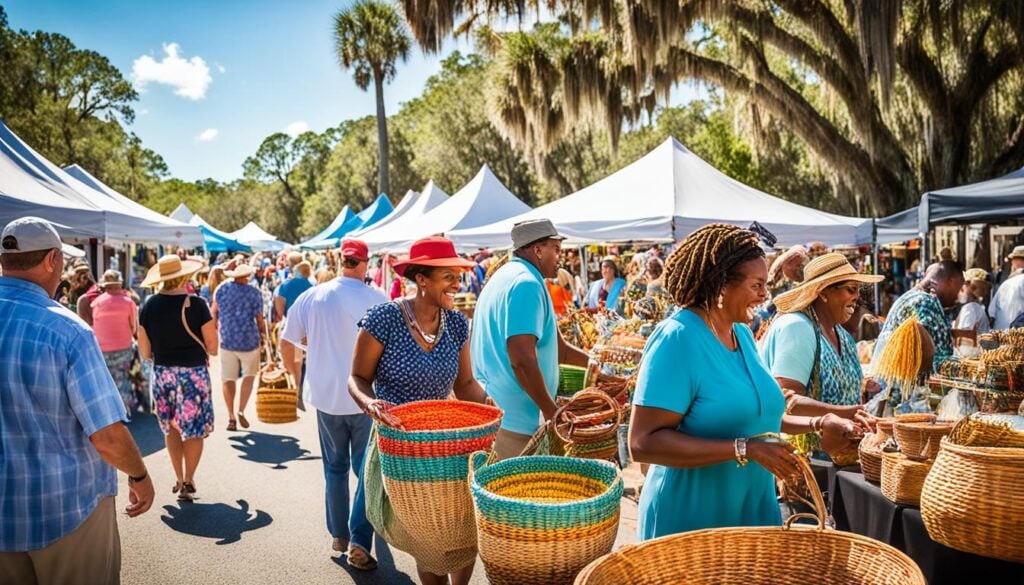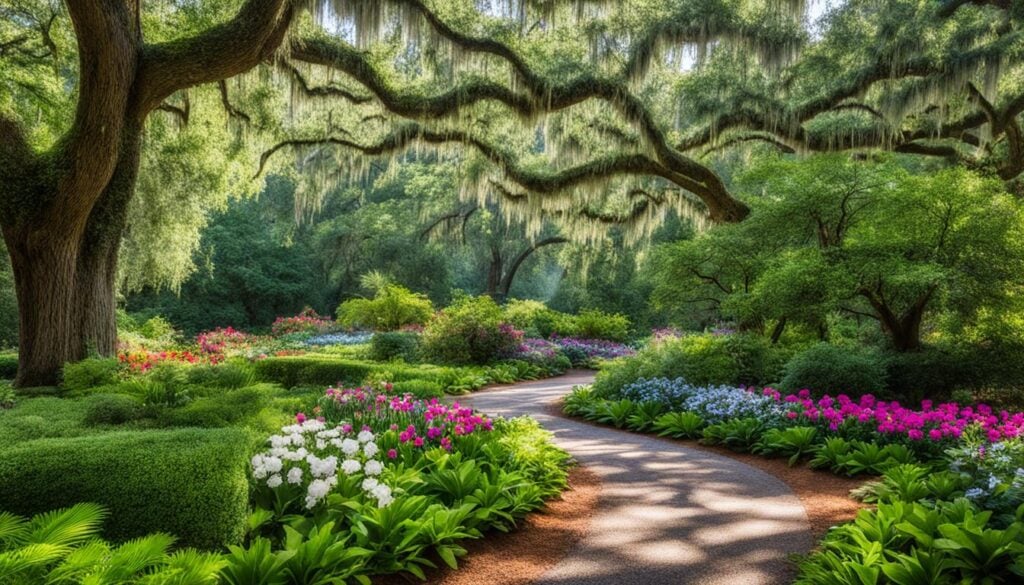Charleston’s antebellum plantations offer a glimpse into the Lowcountry’s complex past. These iconic Southern estates showcase grand homes and lush landscapes. What secrets and stories lie within the walls of these plantation homes?
Explore the legacy that continues to shape Charleston’s experience. Discover the region’s rich history, from the antebellum era to the Gullah people’s resilience.
These plantations provide a multifaceted experience that will leave a lasting impression. You can admire the architecture, enjoy the gardens, and learn about slavery’s impact.
Immerse yourself in the captivating narratives of these historic sites. Uncover the stories that unfold within Charleston’s plantation heritage.
Explore the Legacy of Charleston’s Plantations
Charleston’s South Carolina plantations offer a window into the antebellum South. They showcase the impact of slavery and plantations on the region’s history. Antebellum plantation homes and Lowcountry history tours reveal the complex lives of the enslaved and elite.
These plantations highlight the economic and social structures of the Antebellum era. Visitors can explore grand manor houses and serene gardens. They also learn about the daily lives of those who worked on these estates.
The contrast between luxury and hardship is evident at these sites. It shows the contradictions of a society built on slavery. These places invite reflection on the era’s lasting impact.
South Carolina plantations serve as powerful reminders of the region’s past. They offer a chance to understand the Lowcountry’s history. Visitors can see how this era continues to influence the present.
| Plantation | Architectural Style | Acreage | Crops Grown |
|---|---|---|---|
| Boone Hall Plantation | Georgian | 738 | Cotton, Indigo, Vegetables |
| Magnolia Plantation and Gardens | Antebellum | 500 | Rice, Indigo, Vegetables |
| Drayton Hall | Georgian | 630 | Rice, Indigo, Timber |
Visiting these Antebellum plantation homes offers insight into Charleston’s complex history. You can explore architecture, agriculture, and human stories. These sites provide a unique and thought-provoking experience for all visitors.
“The plantations of the South Carolina Lowcountry stand as a testament to the region’s complex and often painful history. These historic sites invite us to grapple with the contradictions and consequences of a society built on the institution of slavery.”
The Antebellum South and Plantation Life
The antebellum South was shaped by the plantation system. It relied on enslaved Africans and their descendants for labor. Plantation homes showcased the planter class’s wealth and power.
These homes’ architectural styles continue to fascinate visitors today. Their design elements reflect the opulence of the era.
Slavery and the Plantation Economy
Enslaved people were forced to work fields and perform essential tasks. Their labor was crucial for producing cash crops like cotton, tobacco, and rice.
These crops were the region’s main exports. The exploitation of enslaved Africans fueled the plantation system’s economic success.
Architecture and Design of Plantation Homes
Antebellum plantation homes were grand structures that displayed their owners’ status. They often featured classical styles like Greek Revival or Georgian.
Ornate details included columns, pediments, and elaborate furnishings. The region’s climate influenced their design with wide verandas and high ceilings.
“The plantation house was the physical manifestation of the planter’s power and influence in the community.”
Luxurious plantation gardens surrounded these grand homes. They showcased the planter class’s wealth and horticultural skills.
These gardens featured carefully chosen plants, elaborate fountains, and manicured paths. They provided a peaceful escape from the harsh realities of plantation life.
Charleston Plantations: History and Tours
Charleston’s plantations offer a unique glimpse into the region’s rich history. Visitors can explore these historic sites through guided tours or self-guided adventures. Each option reveals fascinating stories and legacies of the past.
Step back in time and discover the Lowcountry’s captivating history. Wander through lush gardens and admire the grand architecture of plantation museums. Uncover complex narratives that shaped the Antebellum South.
Charleston provides experiences for various interests in plantation life. Explore economic, social, and architectural aspects of these historical treasures. Gain a deeper understanding of the region’s fascinating past.
Guided Plantation Tours
Dive into history with expert-led tours by knowledgeable historians and storytellers. These tours offer comprehensive insights into Charleston’s history and tours of plantations. Learn about plantation owners’ lives, slavery’s impact, and the region’s evolving architecture and agriculture.
Self-Guided Explorations
Many Charleston plantations offer self-guided tours for independent explorers. Wander through grand homes at your own pace. Stroll along picturesque gardens and uncover hidden corners of plantation life.
| Plantation | Tour Type | Duration | Highlights |
|---|---|---|---|
| Boone Hall Plantation | Guided and Self-Guided | 1-2 hours | Antebellum architecture, slave cabins, live oak alley |
| Magnolia Plantation and Gardens | Guided and Self-Guided | 2-3 hours | Historic house museum, nature trails, Romantic-style gardens |
| Middleton Place | Guided and Self-Guided | 2-4 hours | Oldest landscaped gardens in America, heritage breed farm, museum |
Charleston’s plantations offer a captivating window into the region’s past. Choose guided tours or self-guided explorations to uncover fascinating stories. Discover the rich history that has shaped the Lowcountry for generations.
Top Plantations to Visit in Charleston
Charleston, South Carolina, boasts historical plantations that showcase the region’s Lowcountry heritage. Two standout destinations are Boone Hall Plantation and Magnolia Plantation and Gardens. These sites offer unique glimpses into the past.
Boone Hall Plantation
Boone Hall Plantation is a living testament to the Antebellum South. Its iconic avenue of oak trees draped with Spanish moss is breathtaking. The well-preserved main house showcases architectural grandeur.
Former slave cabins provide a poignant reminder of the region’s complex history. These structures offer insight into the lives of those who lived and worked here.
Magnolia Plantation and Gardens
Magnolia Plantation and Gardens is a horticultural marvel. Its centuries-old gardens have been meticulously maintained and expanded over generations. Visitors can explore lush, serene landscapes that captivate the senses.
The famous “Swamp Garden” offers a unique ecosystem to discover. The historic “Orientation Center” houses exhibits about the plantation’s history and Gullah culture.
| Plantation | Highlights | Unique Features |
|---|---|---|
| Boone Hall Plantation |
|
|
| Magnolia Plantation and Gardens |
|
|
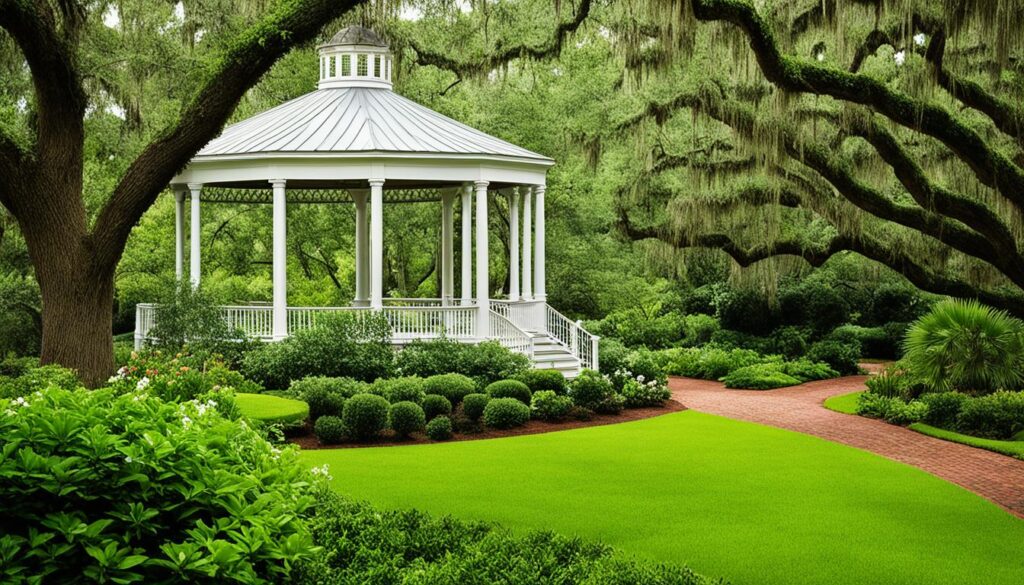
These Charleston plantations offer rich, multifaceted experiences for visitors. Explore the architectural grandeur of the Antebellum South and the Lowcountry’s natural beauty. Discover the region’s captivating history and culture through these remarkable sites.
The Gullah Culture and Lowcountry Traditions
The Gullah people’s cultural heritage is deeply rooted in the Lowcountry region. They are descendants of enslaved Africans who have preserved their unique traditions. Gullah culture tours and Lowcountry history tours offer glimpses into this vibrant community’s past.
Plantation museums and plantation gardens provide immersive experiences. These tours allow visitors to appreciate the intricate tapestry of Gullah culture. You can explore their language, a creole dialect blending West African and English influences.
Traditional Gullah foods include rice, okra, and sweet potato dishes. Witness the skilled artistry of Gullah sweetgrass basket weavers. Their intricate baskets have been passed down through generations.
Exploring Gullah culture offers insights into the Lowcountry’s history and plantation era legacy. These experiences inspire appreciation for the Gullah community’s resilience and adaptability. Their traditions continue to enrich the Lowcountry landscape.
Plantation museums and Gullah culture tours showcase this remarkable heritage. You’ll be captivated by the richness of Gullah traditions. Immerse yourself in the Lowcountry’s vibrant past and gain a holistic understanding of the region.
Slavery, Resistance, and the African American Experience
Charleston’s plantation history is deeply tied to enslaved Africans and their descendants. This chapter explores the harsh realities of slavery and plantations. It also highlights stories of resistance and resilience from this painful era.
Many plantation museums now offer educational programs about this complex history. These Lowcountry history tours aim to reveal the experiences of the enslaved. Visitors gain deeper insights into slavery’s impact on the region.
Understanding the Painful History
Charleston’s plantations were built on the labor of enslaved Africans. They faced brutal conditions, family separations, and dehumanization. The slavery and plantations system left a lasting mark on the region’s history.
“The true history of slavery is complex, nuanced, and often difficult to confront. But it is a history we must understand if we are to move forward and heal the wounds of the past.”
Today, plantation museums present this history with honesty and sensitivity. They highlight stories of resistance and resilience from the enslaved community. Interactive exhibits and programs foster appreciation for the African American experience.
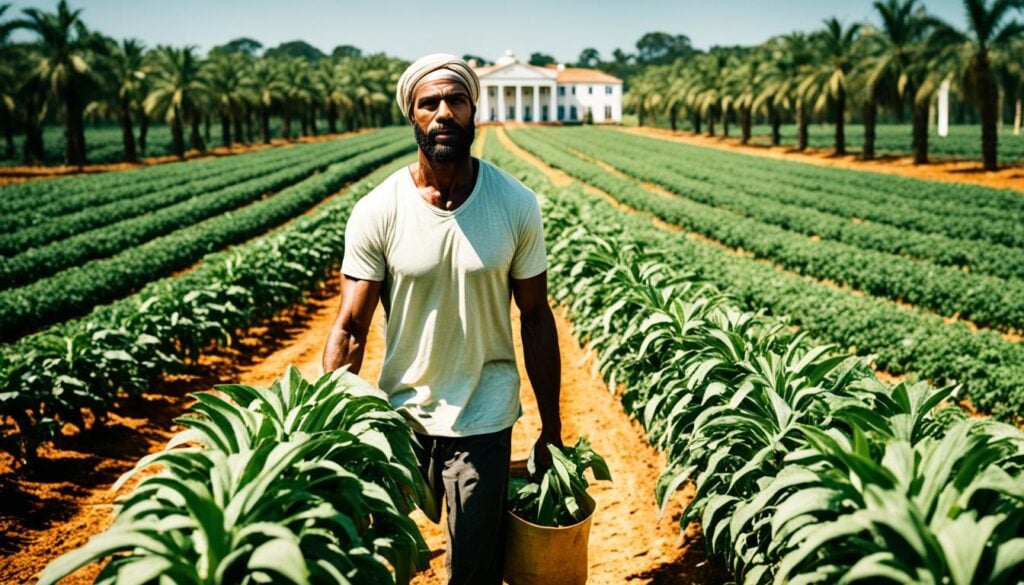
Visitors to Charleston’s plantations can explore this complex history. They gain insights into the region’s past and the ongoing legacy of slavery and plantations. It’s a story of struggle and perseverance that shapes the Lowcountry’s culture.
Plantation Gardens and Natural Beauty
Charleston’s plantations offer stunning landscapes and meticulously curated gardens. Centuries-old live oak trees draped in Spanish moss create a serene atmosphere. These scenic settings contrast with the complex social histories of the sites.
Exploring the Scenic Landscapes
The Plantation gardens of Charleston’s Lowcountry are masterpieces of nature and design. Magnolia Plantation and Gardens showcases diverse flora, from fragrant azaleas to towering cypress trees. Boone Hall Plantation features a scenic tree-lined avenue leading to the historic mansion.
The plantations’ natural habitats are equally captivating. Visitors can explore serene wetlands, verdant forests, and tranquil waterways teeming with local wildlife. These Plantation museums offer a unique opportunity to immerse oneself in the region’s rich ecology.
| Plantation Garden | Highlights |
|---|---|
| Magnolia Plantation and Gardens | Diverse flora, including azaleas, camellias, and cypress trees |
| Boone Hall Plantation | Iconic tree-lined avenue leading to the historic mansion |
Exploring Charleston’s plantation landscapes offers insight into the region’s environmental heritage. Visitors can appreciate the delicate balance that has sustained these iconic sites for centuries. These natural wonders provide a unique perspective on the plantations’ enduring legacies.
Educational Programs and Plantation Museums
Charleston’s plantation sites now offer educational programs and museum exhibits. These resources provide a deeper understanding of their complex histories. They explore the lives of the enslaved, architectural elements, and the broader context of the American South.
Educational offerings at these sites can enrich your understanding of Charleston’s plantation legacy. The Slave Mart Museum delves into the domestic slave trade’s painful history. Magnolia Plantation and Gardens highlights Gullah culture and enslaved people’s experiences.
Plantation museums showcase the architectural elements of the antebellum South. You can explore stately columned mansions and intricate hand-carved moldings. Interactive displays bring stories of the enslaved to life.
These exhibits shed light on daily lives and resistance efforts. They also reveal the long-lasting impact of the plantation system. Visitors gain insights into this complex chapter of American history.

































